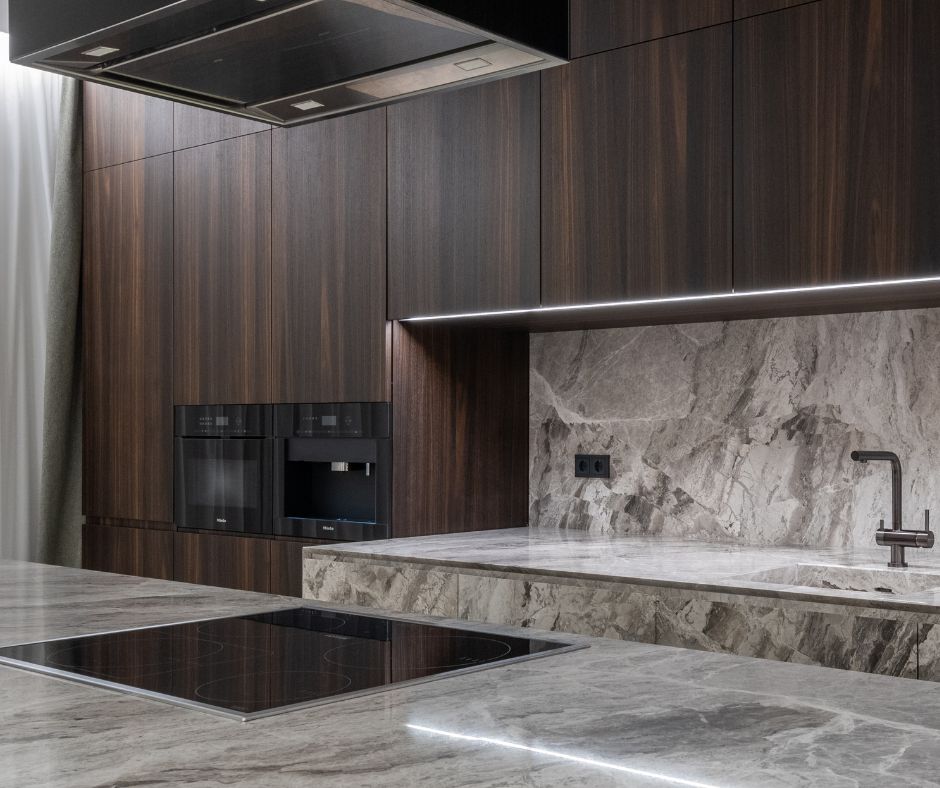Innovative kitchens are at the forefront of culinary evolution, creating exciting new cooking traditions. While induction cooking technology may appear to be a contemporary innovation, its roots date back to the early 20th century. The initial demonstrations in the 1930s mesmerised audiences with the astonishing capability to heat water using magnetic energy without any visible heat source. However, it has only been in recent decades, driven by significant advancements in technology, efficiency, and design, that induction cooktops have firmly established their presence in modern kitchens.
Today, a growing number of home chefs and culinary aficionados are embracing induction cooking due to its stunning blend of sleek aesthetics, exceptional precision, and unmatched energy efficiency. This innovative cooking method not only accelerates meal preparation but is also revolutionising the art of home cooking, combining the science of heat management with culinary creativity in every dish prepared on its elegant, polished surface. The right induction cooktop can compete with the speed of a microwave in crafting delicious family meals!
Enhance Your Culinary Skills: Unlocking Flavour and Nutrition with Precision Cooking
In contrast to traditional gas or electric ranges, induction cooktops directly heat cookware through electromagnetic energy. This revolutionary approach eradicates wasted heat, prevents burnt edges, and offers superior control over both low and high temperatures. When you can manage heat with such precision, your ingredients retain more of their natural moisture, flavour, and nutritional integrity. Whether you’re flash-searing proteins, gently simmering sauces, or quickly blanching vegetables, induction cooking facilitates the achievement of perfect results with ease, steering clear of overcooked meals and nutrient loss.
Discover the Aesthetic Appeal of Induction Cooktops: Maximising Space While Minimising Cooking Stress
In kitchens where every square inch is precious, induction cooktops shine not only in performance but also in their aesthetic appeal. Their flat, smooth surfaces integrate seamlessly into your countertop, creating a minimalist look that frees up additional space for food preparation, plating, or even enjoying casual meals with loved ones.
Unlike traditional gas hobs, which come equipped with cumbersome grates and protruding burners, induction cooktops sit flush with the countertop. While ceramic stovetops may present a sleeker appearance, they often retain dangerous levels of heat long after the cooking process is complete.
In comparison, induction surfaces cool down rapidly once the cookware is removed. The heat is generated via the magnetic interaction between the cooktop and the cookware itself, as opposed to the cooktop generating heat independently, which means the glass surface retains significantly less heat. This characteristic not only simplifies cleaning but also fosters a safer cooking environment, particularly advantageous for households with children or pets who may be curious about kitchen counters.
The result? A cooler kitchen with cleaner lines and increased flexibility—ideal for contemporary cooks who value both functionality and form.

Your Essential Guide to Selecting the Right Cookware for Effective Induction Cooking
Transitioning to induction cooking might come with a bittersweet realisation—you may need to part ways with some beloved old pans. Since induction technology operates on the principle of magnetic energy for heat generation, not all pots and pans are compatible with this method.
For cookware to function effectively on an induction cooktop, it must be constructed from ferrous (magnetic) metals, such as cast iron, carbon steel, or magnetic-grade stainless steel. A simple fridge magnet test can confirm compatibility: place a magnet on the bottom of the pan. If it sticks firmly, you’re in the clear.
When selecting new cookware, opt for pans with a heavy, flat base. This design ensures optimal contact with the cooktop, delivering even heat distribution crucial for achieving perfect browning, tender roasts, and crispy edges. Additionally, high-quality induction cookware is engineered to resist warping over time, ensuring consistent cooking performance for every meal.
Although it may be difficult to part with old favourites, consider this an upgrade. In exchange, you gain enhanced control, quicker cooking times, and dishes that boast even richer flavours and textures.
Quick Induction Cookware Checklist: Essential Items for Cooking Success
 Conduct a fridge magnet test—strong adhesion indicates induction compatibility
Conduct a fridge magnet test—strong adhesion indicates induction compatibility Prefer flat-bottom pans for optimal contact and heat distribution
Prefer flat-bottom pans for optimal contact and heat distribution Select cast iron, carbon steel, or magnetic stainless steel cookware
Select cast iron, carbon steel, or magnetic stainless steel cookware Avoid cookware composed solely of copper, aluminium, or glass unless explicitly marked for induction
Avoid cookware composed solely of copper, aluminium, or glass unless explicitly marked for induction Look for the induction symbol (resembling a horizontal coil or a series of loops) stamped on the base or package
Look for the induction symbol (resembling a horizontal coil or a series of loops) stamped on the base or package
Pro Tip: The induction symbol typically resembles a zigzag or spring coil graphic. Spotting it guarantees cookware compatibility.
Essential Installation Considerations for Your Induction Cooktop
Before you embark on your culinary adventure with your new cooktop, several critical installation elements must be prioritised:
-
Professional Installation Is Key: Induction units often necessitate dedicated electrical circuits and specific clearances. Ensure you engage professionals who understand these requirements.
-
Hire a Licensed Electrician: Wiring a high-powered induction cooktop is not a DIY task.
Discover why hiring a qualified electrician is imperative. -
Verify Your Power Setup: Some induction models draw substantial power. Before making a purchase, confirm that your wiring meets the cooktop’s specifications.
Proper installation not only guarantees optimal performance but also ensures safety and longevity.
Essential Insights About Induction Cooking
Induction cooking provides more than speed or safety—it is inherently intelligent. With the right cookware and a professionally installed system, you can consistently create better tasting meals, richer textures, and healthier options, meal after meal. In contemporary kitchens, precision cooking has transitioned from a desired feature to a new standard.
Frequently Asked Questions About Induction Cooktops
1. What Makes Induction Cooktops Superior to Gas or Electric Alternatives?
Induction cooktops offer immediate heat control, enhanced energy efficiency, and improved safety features. As they heat the cookware directly, meals cook more rapidly with less energy waste, while the surfaces remain cooler, significantly reducing the risk of burns.
2. Can I Continue Using My Current Pots and Pans on an Induction Cooktop?
Only if they are magnetic. Cookware made from cast iron or magnetic stainless steel is ideal. You can easily check compatibility by placing a magnet on the base—if it adheres firmly, it is suitable for induction use.
3. Does Induction Cooking Impact the Flavour of Food?
Indeed, and in a beneficial manner. Because induction cooking facilitates precise temperature control, you can sear, sauté, or simmer without overheating, thus preserving the natural flavours, textures, and nutrients far more effectively than with inconsistent gas or electric heat.
4. Is Specific Wiring Required for an Induction Cooktop?
Most induction cooktops require a dedicated electrical circuit along with specific voltage and amperage configurations. It is essential to have a professional electrician assess and install your wiring to ensure compliance with safety regulations and to guarantee optimal performance.
The post The Secret Ingredient in Modern Kitchens: Induction Cooktops Are Changing the Game appeared first on https://cookinggods.com
The Article Induction Cooktops: The Game-Changer in Modern Kitchens Was Found On https://limitsofstrategy.com


Your exploration of induction cooking technology raises important questions about how we perceive the evolution of culinary practices and the technologies that support them. To consider induction cooking as a mere evolution of tech is to overlook the cultural significance and potential reformation it brings to home cooking. While the idea of cooking with induction may seem modern, the historical context you provided hints at a far more nuanced journey—one that ties into the broader shifts in how we view food preparation and kitchen tools.
You’ve touched on a crucial aspect of the conversation around induction cooking—it’s not just about the technology itself but how it reshapes our relationship with cooking. The move towards induction does invite us to rethink our cooking practices, often steering us toward a more energy-efficient and precise method.
“To delve deeper into the rich history and cultural implications of cooking technologies like induction, check out our comprehensive guide that beautifully intertwines culinary evolution with the modern kitchen experience.”
https://chandelierjackson.com/emailoctopus
You bring up a crucial point about the cultural significance of induction cooking. It’s fascinating how our kitchen tools reflect deeper societal changes and how we relate to food. As we move into an era where technology deeply intersects with our daily lives, induction cooking offers not just efficiency but also a shift in how we approach the art of cooking. It encourages a more mindful practice—where precision and control are prioritized, yet it can also evoke nostalgia for traditional methods.
“To delve deeper into this fascinating intersection of technology and culinary culture, check out our latest insights here.”
https://chandelierjackson.com/emailoctopus
You’ve touched on something that’s really pivotal. Cooking, in many ways, is as much about culture and personal experience as it is about the technology we use. With induction cooking, it’s fascinating to see how we’re not just talking about a new way to heat a pan; we’re looking at a shift in our relationship with both food and the environment around us.
You’ve brought up a really important point. Cooking isn’t just about preparing food; it’s a reflection of who we are, where we come from, and how we interact with the world. When we think about induction cooking, it’s easy to get caught up in the technical aspects—the sleekness, the speed of heating, the efficiency. But once we delve a little deeper, we start to see a shift in our culinary landscape.